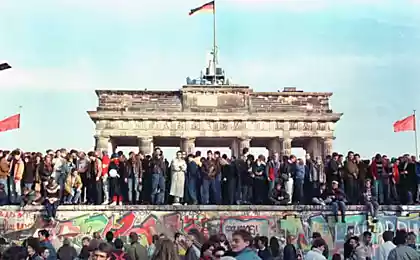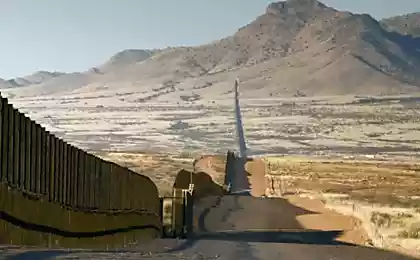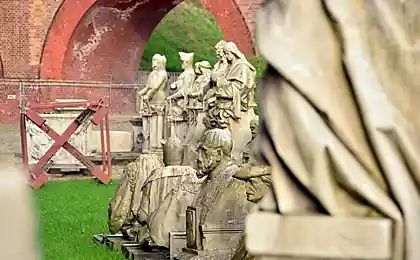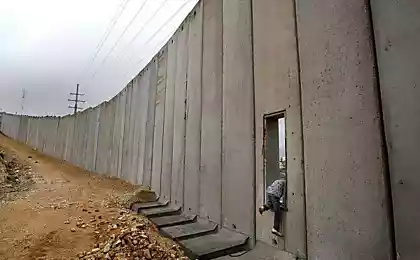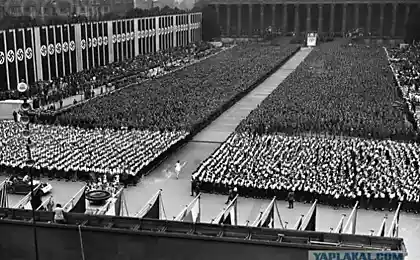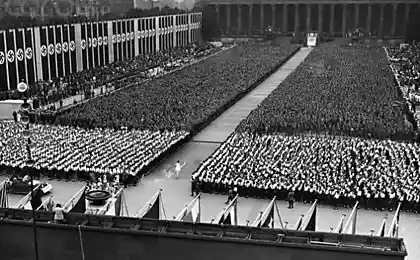208
Creative ways to overcome the Berlin Wall in the recent past
The Berlin Wall separated East Germany from West Berlin and was fortified by watchtowers and dogs, earthen ditches, electrically-stressed signal fences and even stripes of sharp spikes.
From 1961 to 1989, numerous attempts were made to cross the state border, and only those who were endowed with extraordinary thinking and ingenuity managed to do so in very unusual ways.
On the rope. In 1963, circus acrobat Horst Klein made one of the most daring attempts to cross the wall. Thanks to his acrobatic skills, Klein, hanging on his arms, moved on a high-voltage cable directly over the heads of guards patrolling the territory. So he covered thirty meters until he slapped on the ground - but already in West Berlin.
On the steel cable. In 1983, two friends Michael Becker and Holger Betke went even further and, relying on the law of attraction, crossed the border via a steel cable. They climbed into the attic of a five-story house on the east side of the wall, and then Holger fired an arrow with a fishing line tied to it towards the opposite building in West Berlin. Their accomplice on the other side caught an arrow with a fishing line that connected to a steel cable. When the cable was attached to the chimney on the west side, Becker and Betke with the help of wooden rollers "rolled" towards Germany.
No windshield. Austrian turner Heinz Meixner also liked to take risks and in 1963 drove up to Checkpoint Charlie in his rented Austin Healy convertible. Strangely, the car lacked the windshield, which Mikesner had carefully removed (and also hid his mother in the trunk). When security asked him to snuggle up to the curb for inspection, he sharply pressed the gas pedal and bent down. His tiny car slipped in front of surprised border guards right under the barrier separating East from West.
By train. In 1961, a 27-year-old train driver named Harry Detherling decided to ram the wall on the "last train to freedom," as he dubbed it. After breaking the fortifications at a speed of fifty kilometers per hour, Harry and the rest of his passengers safely arrived in the Spandau area in West Berlin. Later, some of the passengers decided to return to East Berlin with their families. Based on the escape of Harry Deterling, the film “Breakthrough Locomotive 234” was filmed.
In a hot air balloon Amazing escape, which in 1979 made mechanic Hans Strelczyk and stonemason Gunther Wetzel as if left the pages of the comics. Introducing their technical know-how, two friends made a balloon out of old propane cylinders, while their wives sewed a balloon shell out of tarpaulin pieces and old sheets. After completing all the preparations, two couples and their children hovered high above the Berlin Wall on their way to freedom.
In uniform However, many of those who guarded the wall from secret scouts were not averse to escape to the west of Berlin. The border guards were in an advantageous position because they were free to cross the border, which many of them took advantage of.
The most famous escape through the wall was made in 1961 by guard Conrad Schumann, just three days after its completion. At that time, the wall was a temporary barbed wire fence about eighty centimeters high, so Schumann could easily jump over it. The photograph of his flying jump is considered one of the iconic images on the theme of the Cold War. Schumann later settled in the southwest of Bavaria, where he worked as a machine operator.
source
Source: /users/1080
From 1961 to 1989, numerous attempts were made to cross the state border, and only those who were endowed with extraordinary thinking and ingenuity managed to do so in very unusual ways.
On the rope. In 1963, circus acrobat Horst Klein made one of the most daring attempts to cross the wall. Thanks to his acrobatic skills, Klein, hanging on his arms, moved on a high-voltage cable directly over the heads of guards patrolling the territory. So he covered thirty meters until he slapped on the ground - but already in West Berlin.
On the steel cable. In 1983, two friends Michael Becker and Holger Betke went even further and, relying on the law of attraction, crossed the border via a steel cable. They climbed into the attic of a five-story house on the east side of the wall, and then Holger fired an arrow with a fishing line tied to it towards the opposite building in West Berlin. Their accomplice on the other side caught an arrow with a fishing line that connected to a steel cable. When the cable was attached to the chimney on the west side, Becker and Betke with the help of wooden rollers "rolled" towards Germany.
No windshield. Austrian turner Heinz Meixner also liked to take risks and in 1963 drove up to Checkpoint Charlie in his rented Austin Healy convertible. Strangely, the car lacked the windshield, which Mikesner had carefully removed (and also hid his mother in the trunk). When security asked him to snuggle up to the curb for inspection, he sharply pressed the gas pedal and bent down. His tiny car slipped in front of surprised border guards right under the barrier separating East from West.
By train. In 1961, a 27-year-old train driver named Harry Detherling decided to ram the wall on the "last train to freedom," as he dubbed it. After breaking the fortifications at a speed of fifty kilometers per hour, Harry and the rest of his passengers safely arrived in the Spandau area in West Berlin. Later, some of the passengers decided to return to East Berlin with their families. Based on the escape of Harry Deterling, the film “Breakthrough Locomotive 234” was filmed.
In a hot air balloon Amazing escape, which in 1979 made mechanic Hans Strelczyk and stonemason Gunther Wetzel as if left the pages of the comics. Introducing their technical know-how, two friends made a balloon out of old propane cylinders, while their wives sewed a balloon shell out of tarpaulin pieces and old sheets. After completing all the preparations, two couples and their children hovered high above the Berlin Wall on their way to freedom.
In uniform However, many of those who guarded the wall from secret scouts were not averse to escape to the west of Berlin. The border guards were in an advantageous position because they were free to cross the border, which many of them took advantage of.
The most famous escape through the wall was made in 1961 by guard Conrad Schumann, just three days after its completion. At that time, the wall was a temporary barbed wire fence about eighty centimeters high, so Schumann could easily jump over it. The photograph of his flying jump is considered one of the iconic images on the theme of the Cold War. Schumann later settled in the southwest of Bavaria, where he worked as a machine operator.
source
Source: /users/1080
Best quotes of the Strugatsky brothers, which will teach you to think outside the box
20 quick tips to clean house




